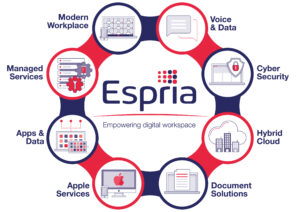Cyber security has become an increasing concern for businesses over the years, but even more so since digital transformation has accelerated, leading to many employees working remotely on a more permanent basis. As work now takes place in a multitude of locations, (be it in the office, at home or in other remote locations) cyber-attacks have been refined and have increased in their number and frequency. Often, according to Managed Services provider Espria, the risks associated with this rise can be forgotten or ignored putting many businesses at risk.
Dave Adamson, CTO at Espria, stated, “Technology that enables secure printing is essential, particularly in the post-pandemic world. An office printer will not only scan or copy but can transmit valuable data and if you use a multifunctional device (an MFD), with greater capabilities and functions, it is already supporting your business with improved efficiency and productivity, but it is also an additional risk.

“A notable cyber-attack occurred when 150,000 printers were hacked by Stackoverflowin. Thankfully, this was just for fun, but the aim was to highlight how vulnerable printers connected to the internet are. This experiment clearly indicated how easy it is for a cyber-attack to occur through our printers. Moreover, once access is secured, the potential for destruction is huge – from accessing the data stored on your printer to DDoS (distributed denial-of-service).”
Another security concern are the paper documents left on your printers by your own staff. It’s all too easy to send something to print and then not pick it up – these documents can be intercepted by hackers who have gained access to your office.
Therefore, you need to secure your printing environment to ensure your documents and sensitive data are protected.
Adamson continued, “According to Quocirca’s latest Global Print Security Landscape report 2022 68% of businesses in the United Kingdom, United States, France, and Germany suffered a print-related data breach in the last year, which resulted in a data loss that cost companies an average of more than £600,000.”
Secure printing is a set of specific standards that prevents unauthorised access to your printing environment either through the network or your devices. These tools and software protect access levels and restrict printing access to only those with permission to use them.
Espria believes there are several key security measures you should implement to ensure you are printing securely:
- Follow Me Printing: This application enables any prints to be held in a queue until the author releases the print job securely at a device of their choice.
- Two-factor authentication: Adding another layer of security, via two-factor authentication whereby a pin is inserted at the device to release the printout.
- Implementation of Print Logging and Audit Trails: Obtain visibility of who is printing what, where and when so that you can monitor your printing security.
- Data encryption: Encoding of your documents and only those with the correct authorisation can decode the information. MFDs can encrypt files stored on their hard drive meaning that should it be stolen, your data remains safe. Also, with encryption or at least password protection, your sensitive data remains safe from being viewed by the wrong people.
.
Adamson continued, “Whether you have a printer or a multifunctional device (MFD), consider how many files are copied, printed, and scanned throughout your working week. Clearly, there is a huge amount of your business data being stored on your device, much of which is highly confidential to your business.”
“If you have secure print software, you can create alerts to notify you of a leak or data breach from one of your network printers. This provides your business with full transparency and accountability of your document workflows,” continued Adamson.
“Unprotected printers and copiers can provide a relatively straightforward way for unauthorised parties to gain access to an organisation’s data. Ensuring devices are fully secure should be a key concern for any business and IT manager.
“To improve security across your workplace, start by completing a comprehensive assessment of all your printers and MFDs – both siloed and networked devices – and identify any potential weak access points. Then approach a trusted print management specialist to help build an improved system,” concluded Adamson.

